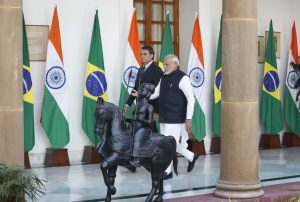The recent visit of Brazil’s president, Jair Bolsonaro, to India has cultivated increased media interest in India’s relations with the South American country. Invited as the chief guest for India’s 71st Republic Day celebration, Bolsonaro attracted attention due to his controversial views on a range of issues. Some have been critical of Indian Prime Minister Narendra Modi’s courtship of Brazil’s new “populist” leader.
New Delhi’s interest in bolstering ties with Brazil’s new leader suggests that it is aware of the potential the bilateral relationship holds. For New Delhi, relations with Brazil are of the highest importance in Latin America and the Caribbean (LAC), which until recently was considered a “forgotten continent” in Indian foreign policy. Bolsonaro’s visit gives us an opportunity to examine India’s engagement with LAC, which, although neglected, has great potential.
India and LAC Relations
Despite LAC’s geographical significance, large population, and economic potential, the region has received little consideration in Indian foreign policy. India’s outreach to the LAC region was long hindered by a geographical disconnect and late realization of the opportunities the region offers. While trade between the two has steadily risen since the first decade of the 21st century, existing literature on India-LAC relations underlines the slow pace of growth in other areas.
Efforts by successive governments in New Delhi to strengthen ties with LAC, it seems, have fixated around augmenting trade and investments in the region. Interest at the highest levels continues to be motivated by an understanding of LAC as an alternative “resource-rich” region that could meet the demands of India’s future energy needs. In the absence of any effective framework and activism to transform its engagement with the region, India’s position in LAC remains low key, in contrast to the other extraregional power, China.
As of 2019, India has established a diplomatic presence in only 15 LAC countries; there are more resident missions from the region in New Delhi. In 2010, India’s then-Minister of State for External Affairs Shashi Tharoor announced the opening of embassies in Ecuador, Uruguay, and the Dominican Republic – that proposal, however, remains unrealized. While under the Modi government’s foreign policy activism India has engaged other regions such as West Asia from a strategic perspective, there seems to be little concern in reviewing the current state of relations with LAC.
Despite this inconsistent interest, a Inter-American Development Bank (IDB) report released in 2011 outlined India as “the next big thing” in Latin America. Similarly, a 2016 report by the United Nations Economic Commission for Latin America and the Caribbean (ECLAC) suggests that the LAC countries could enhance trade and economic relations with India by undertaking structural adjustments in their economies. It is this optimism and expectation that sustains the region’s interest in India. From a wider perspective, the strengthening of India’s profile in the region provides LAC an opportunity to diversify away from China – which many view as pushing LAC into a “raw materials” corner apart from turning it into a dumping ground for cheap consumer goods.






























